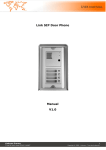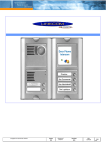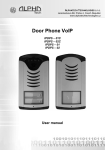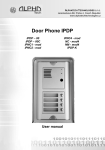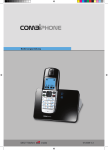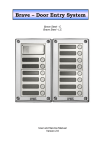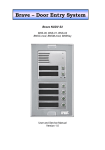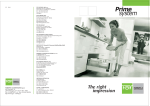Download 2516 KB
Transcript
Mod. 1145 DS1145-019 LBT8072 COMBIPHONE OUT DOOR Ref. 1145/1 Ref. 1145/2 Ref. 1145/4 Ref. 1145/14 USER MANUAL TABLE OF CONTENTS TABLE OF CONTENTS................................................................................................ 2 1 BASIC DESCRIPTION ............................................................................. 3 1.1 1.2 1.3 Features.................................................................................................... 3 Module Assembly ..................................................................................... 3 Module Features....................................................................................... 4 NUDV Basic Module 4 Buttons Module 1145/4, 1145/14 1.4 Installation of Guard Assembly ................................................................. 7 Installation on Plaster Flush-Mounted Installation 2 2.3 Guard 8 Call............................................................................................................ 8 2.3.1 2.3.2 Outgoing Call Incoming Call 8 8 PROGRAMMING OF PARAMETERS................................................................. 9 3.1 Programming through Phone.................................................................... 9 3.1.1 3.1.2 4 7 7 ALL-PURPOSE GUARD OPERATION ............................................................... 7 2.1 Signaling Overview ................................................................................... 7 2.2 Combi Out Door........................................................................................ 8 2.2.1 3 4 6 Entry to Programming Programming of parameters 9 9 6 7 DESCRIPTION OF PARAMETERS .................................................................. 10 4.1 Direct Dialing – Memories....................................................................... 10 4.2 Switches.................................................................................................. 10 4.3 Basic Parameters ................................................................................... 11 4.4 Time Parameters .................................................................................... 12 4.5 Presetting and Deleting .......................................................................... 14 4.6 Programming Termination ...................................................................... 14 4.7 Overview of Parameters ......................................................................... 15 4.8 List of Presetting Parameters ................................................................. 17 TECHNICAL PARAMETERS............................................................................. 18 5.1 Electrical Parameters.............................................................................. 18 5.2 Mechanical dimensions .......................................................................... 19 TABLE FOR EASY PROGRAMMING ............................................................... 20 WIRING DIAGRAM............................................................................................ 23 2 DS1145-019 5 1 BASIC DESCRIPTION 1.1 FEATURES • • • • • • • • • • • • • • • • • • • Modular system allows to connect max 64 buttons Voice communication is supplied only from telephone line Impulse and tone dialing (DTMF) Two 16digit numbers with each button (day/night mode) Day/night switching Possibility of the call extension by * or # choice Possible to connect two independent locks for door opening (DTMF activation) Possible use of 5 switch modes (e.g. camera, lighting, gradual opening) Two codes for hanging up the guard from telephone Two codes for door opening from telephone Optional number of rings before taking an incoming call Optional time among button pressing by code entry Optional time of hanging up when the choice is repeated Optional time before choice start Optional parameters of tone choice, length of Flash and Pause Possible programming by remote control Integrated heating of printed circuit for climatically hostile atmospheres installation Permanent lighting through visiting cards (optional power supply) Protection against static electricity 1.2 MODULE ASSEMBLY The Door Guard structural elements are the basic modules with two (1145/2) or one (1145/1) buttons and extending button module 1145/4 and 1145/14 with four buttons. 1145/2 1145/62 DS1145-019 1145/1 1145/312 1145/612 1145/4 1145/14 1145/712 1145/52 3 Examples of frame configuration 1.3 MODULE FEATURES NUDV Basic Module The 1145 basic module is supplied in two variants, with two buttons 1145/2 and one button 1145/1. Setting volume of speaker Programming jumper (short – don’t needed password) Setting volume of microphone 1145/4 Expansion Jumper – short is switch on temperature heating basic board TRH Setting level for activation microphone Connect flat cable for extending up to 64 buttons or for connect keyboard Connect telephone line Connecting to earth – protect against static electricity Contact 1 switch Contact 2 switch Power supply 12V ac/dc For two switches, lighting heating and Fig. 1 Rear view of basic module To ensure the basic function the terminal “a b LINE” can be connected to a PABX extension. It is connected in the same way as any telephone to any branch exchange to the maximum distance of 300m. The guard’s circuits are supplied from telephone line, so that nothing should be connected for voice communication. If one or two switches are necessary to be used, the A.C. voltage of min. 10Vst - max. 15V or D.C. voltage of min. 12V to max. 18V must be energized to "12V" terminal. This source loading depends on number of modules, since it simultaneously serves feeding of lighting through visiting cards – at max. number of connected modules the demand will not exceed 300mA. This source can be also used for feeding of lock(s), and then it is necessary to consider the electrical lock demand. In practice the alternating feeder 12V/1A mostly meets these demands. The connection of switch contact terminals is shown on fig. 1. The "NO" designation means an idledisconnected contact, "COM" means a pin contact (middle) and "NC" means an idle-connected contact. The contacts of both switches are galvanically isolated each other and from other guard circuits. The variants of connection are shown on fig. 2. The "G" Faston 2.8mm necessary to connect the device to earthing. The "HEAT" jumper serves the switching of board heating. This function requires the connection of 12V supply on "12V" marked terminal. The "EXPANSION" marked connector serves the connection of extending modules by means of flat cable. The "PRG" marked connector provides the guard adjustment from PC by means of serial cable (KAB) and serves to the service for diagnostics and new software load. The "SERVICE" jumper serves to direct access to programming. It can be used, for example by absence of password for programming. 4 DS1145-019 Note: It’s better to connect the device on the expansion not interested to the emergency condition (when the power supply is not connected) 1145/1-2 1145/1-2 For lighting and control of switch Power Supply 12V/1A Lock 1 Lock 2 Power. Aliment Supply 12V/0.3A 12V/0,3A Lock 1 Lock 2 For power lock (other voltage) 1145/1-2 + Camera Electromagnetic holding lock - Power Aliment. Supply 12Vcc with 12Vcc back-up Lock 1 Power Aliment. Supply 24V/1A 24V/1A Additional bell Power Aliment. Supply 12V/1A 12V/1A Fig. 2 Examples of switch connections Setting voice communication Position trimmers are presetting from manufacture and in majority case agree with, therefore changes setting altering only in necessary case. Trimmer "MIC" be instrumental to setting loudness of microphone, trimmer "SPK" be instrumental to setting loudness loudspeaker. In this version is big reserve in gain, therefore isn't recommended adjust more than on half, typical is in 1/3 from minimum gain. Trimmer "TRH" be instrumental to setting levels activation of microphone, it means, so as doorphone "non whoop" owing to acoustic loop so selection, which direction has priority, whether from microphone, or into loudspeaker. Level from which volume with "switch on" direction from microphone doorphone setting trimmer „TRH". This setting interact level surrounding noise and setting gain of microphone „MIC". Progress of setting: setting the TRH, SPK and MIC trimmer like in figure (base setting) and test the comunication. Setting the SPK and MIC trimmer if there are problems or particular working situation. DS1145-019 5 Other Setting If the audio level of the telephone is too low set the MIC trimmer in hour sense until the level is good. If the audio level of the telephone is too high set the MIC trimmer in anti hour sense until the level is good. If the audio level of Combiphone Out Door (1145/X) speaker is too low set the SPK trimmer in hour sense until the level is good If the audio level of Combiphone Out Door (1145/X) speaker is too high or distorted set the SPK trimmer in anti hour sense until the level is good If after these setting the audio level is not satisfactory set the TRH trimmer in hour sense. Note: In case of regulation of TRH trimmer it could be necessary to set again the SPK and MIC trimmer. 4 Buttons Module 1145/4, 1145/14 This module is supplied in two designs. The Ref.1145/4 module has four buttons and includes the electronics to be connected to the basic module or to previous Ref.1145/4 module. This module is only connected by flat cable – buttons and lighting through is already interconnected, the flat cable connection is facilitated by connector locks, preventing from rotation, but to keep the connection routing is imperative. The Ref.1145/14 module is always connected to previous Ref.1145/4. The connection is not prepared and should be done by conductors (see system installation). Connection flat cable direction to basic modul Connection flat cable direction to 1145/4 1145/X To 1145/84 To 1145/4 1145/X 1145/4 1145/4 Alternative connect power for lighting Connecting 4 buttons and common (GND) Connecting two wires use for connect power for lighting 1145/14 1145/4 1145/14 1145/14 Fig. 3 Connection of 1145/4 to 1145/14 and connection of modules 6 DS1145-019 1.4 INSTALLATION OF GUARD ASSEMBLY Installation on Plaster By installation on plaster the only compact box 1145/5X - Rain-Protective Cover 1145/3XX is used, which will supersede all mechanical parts. The installation is made by screwing to the wall by means of dowels. See 1145/311 on figure. Flush-Mounted Installation The 1145/5X mounting box is built-in wall. Be careful in orientation of assembling holes when nearly 1145/51 square box is used – it must be in vertical axis. The Protecting Frame (provides overlapping of unevenness after mounting box walling-in) and Canopy (necessary for installation in external areas) form other accessories for flush-mounted installation. When installed in surroundings with possible water condensation (temperature changes) or rain, it is recommended to connect the jumper on basic module – heating ON. The board heating has two positive functions partly it heats up the electronics in winter and partly avoids water condensation occurs on basic guard board. 2 ALL-PURPOSE GUARD OPERATION 2.1 SIGNALING OVERVIEW The all-purpose guard signals an acoustic conditions they may occur during operation. Another signaling can be done by means of red LED (placed under microphone hole). You can listen the signaling samples in Nset setting program. Condition Tones Tone frequency LED Line lifting up –▄–■–▀– 425-850-1275 glows Line hanging up –▀–■–▄ 1275-850-425 goes out Report after calling –▄–■–▀– 425-850-1275 glows ––█–– 425 Command phone confirmation from Dialing goes out DTMF/Pulse Call glows Notice about call end –■–■–■– 1275 glows Entry to programming from phone –■–■–■– 850 glows ––▓–▓––––– mod. 850 glows Programming from phone Parameter confirmation Connection to line (Reset) ––█–– glows –■–▄–■– 1275-850-1275 Error (anything, if unsuitable) –■–■–■–■–■–■– 425…. Empty memory (no progr. numb.) –█–▄–■–▄–■–▄– 850-1275-1700… DS1145-019 blinks 7 2.2 COMBI OUT DOOR The Combi out door is influenced partly by used guard assembly and partly by setting of guard parameters (see chapter “Parameter Overview”). 2.2.1 Guard The guard buttons are provided by nameplates or positions of persons inside the object. The incoming person will press the corresponding button, the guard will lift up the line neither immediately (the button is not the first number from code lock), or with delay (parameter 53) and after period given by parameter 55 will dial the programmed phone number. The dialing number differs by choice mode, which is set in the guard (parameter 47): • Day/night mode = being the guard in Day mode, so it is always dialing a number set in parameter 1, in Night mode, it is always dialing a number set in parameter 2. The mode switchover is set in parameters 45,46. • mode of second number group = first press – it always dials a number set in parameter 1. By repeated press of the same button or detection of busy tone after dialing the guard will select the number from the second group (parameter 2). The next press of the same button again selects a number of the first group, etc..…… If a visitor presses the button after guard lifting up, so the guard will hang up for a period given by parameter 54, lift up the line and dial a new number. The number choice is carried out both tone (DTMF), and pulse dialing according to parameter 41 setting. 2.3 CALL 2.3.1 Outgoing Call The outgoing call is the call from guard (caused by visitor) to the telephone. After guard choice the telephone is ringing inside object and the lifting up will allow speaking to the visitor at door. It’s possible with DTMF code • close the switch (parameter 35) • change over the Day/Night modes (parameters 45,46) • hang up (parameter 43). The guard in 10 seconds before call end (parameter 52) will send a notice about call end and the call may be extended by sign selection (parameter 42). The telephone hanging up will end the call (the exchange is sending a busy tone on guard’s line and the guard also will hang up). To end the call digit the default number 34 (parameter 43), if you don’t digit that number the call end will arrive from PABX if it recognize the tone or when the conversation time, setting from parameter 52 (1 minute default), will finish. 2.3.2 Incoming Call The incoming call is the call from guard (caused by person inside object). After exchange number selection, where the guard is connected, the guard’s line is ringing and when set number of rings is over (parameter 51), the guard will lift up and it is possible to speak. The possibilities are the same as with outgoing call (Chapter 2.3.1). Except the first 10 seconds, where extra "# and service password" (parameter 44) can be entered, the guard then will proceed with programming mode. The other exception of incoming call is by connected “SERVICE” jumper. The guard after line lifting up proceeds then with programming mode (without service password). To end the call digit the default number 34 (parameter 43), if you don’t digit that number the call end will arrive from PABX if it recognize the tone or when the conversation time, setting from parameter 52 (1 minute default), will finish. 8 DS1145-019 3 PROGRAMMING OF PARAMETERS 3.1 PROGRAMMING THROUGH PHONE 3.1.1 Entry to Programming The all-purpose door guard will be set to programming mode in two ways: 1. by password – hook off the telephone and dial a number, where the guard is connected. The guard will answer (you hear tone for answering – see Chapter 2.1 of complete manual) up to 10 sec dial #xxxx, where xxxx is the service number for entry to programming and if O.K., the registration tone to programming will sound and afterwards the programming tone is heard. 2. by "SERVICE" jumper – you will realize the connection with guard in the same way as in art. 1, but when the SERVICE jumper is connected, then the guard after answering directly comes to programming mode – you hear tone for answering, registration tone to programming and afterwards the programming tone is heard. 3.1.2 Programming of parameters The initial state for programming is signaled by programming tone and the guard will come back to this state always after time expiration (5 seconds) even if the programming is not finished. When programming two types of parameters will occur. Partly they are parameters with fixed length – the majority of them they are, then the programming is affirmed and the parameter is always recorded immediately after mandatory length fulfillment by acknowledge tone and partly the parameters with variable length (parameter 1,2,32,33,34), followed with confirmation and the recording of the parameter after inactivity period expires (5 sec). The only case with immediate recording of parameters is the fulfillment of max. number of recorded signs (numbers) – by parameters 1 and 2 it is 16, by parameters 32,33,34 it is 6. If during programming you enter number (sign) not allowable by its extent then the guard immediately emits an error tone, the parameter will not be recorded nor changed, the guard will come to initial state and it is possible to repeat the parameter setting or program another parameter. The guard stays inactive in programming mode for 34 seconds, then he will automatically hang up. By every dialing of DTMF tone this period is set up repeatedly. The selection of parameter 9 can also end the programming mode. Note: if you wish to keep the connection (extend the 34 seconds period) than the customer will think over the other setting, so pressing e.g.. 6, 7, 0, * or # form time to time will be sufficient and the guard immediately responds by error tone, but he will extend the period to hanging up.. Note: The # sign is not used by entering of 32,33,34 parameters can be used for immediate parameter entering. DS1145-019 9 4 DESCRIPTION OF PARAMETERS 4.1 DIRECT DIALING – MEMORIES Parameter Value Meaning Basic Exam.1 Exam.2 1 tt nn… No. nn under button tt - - - tt nn Button number (memory), always set in two-digit manner [01-64] telephone number up to 16 digits, we want to store. To store other choice flags the assignment given in table is used. The numbers stored in parameter 1 are the number of the first group or numbers of Day mode. Neither basic setting nor settings per examples do not change or delete the stored numbers. mean. 0-9 # * Flash Pause choice 0-9 # ** *# *0 Parameter Value Meaning Basic Exam.1 Exam.2 2 tt nn… No. nn under button tt - - - tt nn Button number (memory), always set in two-digit manner [01-64] telephone number up to 16 digits, we want to store. To store other choice flags the assignment given in table is used.. The numbers stored in parameter 2 are the number of the second group or numbers of Night mode. Neither basic setting nor settings per examples do not change or delete the stored numbers. List of related parameters: 41 45 46 47 48 49 57 58 59 50 81 82 mean. 0-9 # * Flash Pause choice 0-9 # ** *# *0 4.2 SWITCHES Parameter Value Meaning Basic Exam.1 Exam.2 31 rm switch r works in m mode 11 21 11 22 11 25 r m m=1 switch number [1-2] switch mode [for r=1 1-4 , for r=2 1-5] switch mode – it will close on command or password for ss period (used for electrical locks, gate opening etc.) m=2 camera mode – it will close by guard lifting up and open by hanging up. m=3 lighting mode – it will close by guard lifting up and stay closed even for ss period after guard hanging up (the line is engaged for this period). m=4 switch mode – it will close after button pressing and open after ss period (used for e.g. external bell or horn connections). m=5 gradual opening mode – in this mode the only switch 2 will be set together with switch 1 set to mode 1. The switch 1 is activated for ss period, then the time xx is proceeding before switch 2 closing. Then the switch 2 is activated for ss period and afterwards the guard hangs up. Note: The only switch 1 can be activated from phone and all sequence started. Besides that the switch 2 can be separately activated from buttons by password. List of related parameters: 32 33 34 35 36 37 38 8# 83 10 DS1145-019 Parameter Value Meaning Basic Exam.1 Exam.2 35 r aa command aa from phone after r switch closing 155 266 155 266 155 266 r switch number [1-2] aa command from phone after switch closing [2 digits] The same command can be set for both switches, then they are activated at the same time. The advantage is to set the same command both for switch closing and command to guard hanging up (parameter 43) aa=bb. List of related parameters: 31 36 37 38 43 8# 83 Parameter Value Meaning Basic Exam.1 Exam.2 36 r ss ss period [sec] of r switch closing 105 205 102 202 105 205 r switch number [1-2] ss duration of switch closing [2 digits 01-99] List of related parameters: 31 32 33 34 35 37 38 8# 83 Parameter Value Meaning Basic Exam.1 Exam.2 37 rp r switch control by incoming call 11 21 11 21 11 21 r switch number [1-2] p parameter, if p=1 allowed or p=0 prohibited to control the switch during incoming call. To prohibit the control during incoming call is important e.g. when using switch 2 in mode 1 for control of garage gate opening, when the electronics opens the gate and the gate is closed by car passage. Then the control from phone could undesirably cause the permanent gate opening (not closed – no car passage). List of related parameters: 31 35 8# 83 Parameter 38 Value Meaning Basic Exam.1 Exam.2 xx xx period [sec] between switches 1 and 2 closing 10 10 15 xx – time between close switches 1 and 2 by m=5 mode setting (gradual opening) [2 digits 01-99] List of related parameters: 31 32 33 34 35 36 37 8# 83 4.3 BASIC PARAMETERS Parameter Value Meaning Basic Exam.1 Exam.2 41 v choice type v – tone / pulse 0 0 0 v choice type v=0 is DTMF tone choice, v=1 is pulse choice List of related parameters: 1 2 8# 84 z Parameter Value Meaning Basic Exam.1 Exam.2 42 z sign for call extension * * * sign for call extension * or # (10sec before call end the guard will send a notice, then the call may be extended) List of related parameters: 52 8# 84 DS1145-019 11 Parameter Value Meaning Basic Exam.1 Exam.2 43 g bb command for guard hanging up from phone 134 235 155 244 155 244 g command order [1-2] (two commands in order to hang up the guard using both switches) bb command for guard hanging up from phone [2 digits] List of related parameters: 35 8# 84 Parameter Value Meaning Basic Exam.1 Exam.2 44 xxxx service password 0000 0000 0000 xxxx service password for entry to programming List of related parameters: 8# 84 Parameter Value Meaning Basic Exam.1 Exam.2 45 dd command for DAY switching 11 11 11 46 nn command for NIGHT switching 10 10 10 dd command for DAY mode switching [2 digits] nn command for NIGHT mode switching [2 digits] Note: The switchover to Day/Night mode remains set in guard even after line disconnection. List of related parameters: 1 2 33 34 47 8# 84 Parameter Value Meaning Basic Exam.1 Exam.2 47 e mode of guard choice 1 1 0 e mode of guard choice e=0 selects numbers of the first and second groups, e=1 selects number per Day/Night guard mode. List of related parameters: 1 2 8# 84 Parameter Value Meaning Basic Exam.1 Exam.2 48 c keyboard connection 0 0 1 c c=0 only NC-mode connected to the basic module ATTENTION: This parameter setting will sharply influence whole guard function. List of related parameters: 1 2 32 33 34 47 49 53 8# 84 4.4 TIME PARAMETERS Parameter Value Meaning Basic Exam.1 Exam.2 51 q number of rings before guard call lifting up 2 1 2 q Number of incoming call rings, the guard lifts up among rings namely 2 sec. after detection q – times rings. The number can be set from 1 to 9. List of related parameters: 44 8# 85 12 DS1145-019 Parameter Value Meaning Basic Exam.1 Exam.2 52 d max. call time 1 2 1 d – max. time, for which the guard is hanging up, this time can be extended during call by sign choice from telephone (* or #). Time setting is per table. List of related parameters: 42 8# 85 time [min] 0,5 1-9 15 30 choice 0 1-9 * # Parameter Value Meaning Basic Exam.1 Exam.2 53 w time among button presses 2 2 2 w max. time [sec] among button presses [range 1-9] Note: switch closing – if time between two next presses is bigger than w time, the code is not evaluated correctly. List of related parameters: 1 2 32 33 34 47 48 49 8# 85 Parameter Value Meaning Basic Exam.1 Exam.2 54 z time of hanging up when dialing repeated 2 2 2 z time [sec] for which the guard will hang up, before repeated dialing (button pressing during call or dialing, busy tone detection) [range 1-5] List of related parameters: 8# 85 Parameter Value Meaning Basic Exam.1 Exam.2 55 z time before dialing 1 1 1 z time [sec] after guard lifting up before dialing [range 1-5]. This time is different for each exchange, but most central exchanges usually manage to process dialing up to 2 seconds after line lifting up. List of related parameters: 8# 85 Parameter Value Meaning Basic Exam.1 Exam.2 56 h number of rings before hanging up 12 12 12 h after finishing the dialing it calculates number of KVT (ringing tones). If the number exceeds h value, it will hang up [range 04-99]. The dialing is repeated in case, when the dialing mode of 2 groups is set. List of related parameters: 47 8# 85 Parameter Value Meaning Basic Exam.1 Exam.2 57 t DTMF tone duration (tone) choice 5 (100ms) 5 (100ms) 5 (100ms) DS1145-019 13 58 m gap duration among DTMF tones 5 (100ms) 5 (100ms) 5 (100ms) 59 f Flash duration 1 (100ms) 1 (100ms) 1 (100ms) 50 p pause duration / interdigit gap 8 (800ms) 8 (800ms) 8 (800ms) t DTMF tone duration is determined per formula: (entered number + 5) x 10 = tone duration [ms] [range 1-0 i.e. 60-150ms] gap duration among DTMF tones is determined per formula: (entered number + 5) x 10 = gap duration [ms] [range 1-0 i.e. 60-150ms] Flash duration is determined per formula: entered number x 100 = Flash duration [ms] [range 1-6 i.e. 100-600ms] pause duration is determined per formula: entered number x 100 = pause duration [ms] [range 5-0 i.e. 500-1000ms] p time is simultaneously the duration of interdigit gap at pulse dialing. m f p List of related parameters: 1 2 41 8# 85 4.5 PRESETTING AND DELETING Parameter Value Meaning Basic 8# # basic setting executes 8# 1 setting per exam. 1 8# 2 setting per exam. 2 Exam.1 Exam.2 executes executes This setting does not influence 1 and 2 (numbers stored in memory) Parameter Value 81 82 83 84 85 Meaning Basic deletes all numbers in group 1 (Day mode) deletes all numbers in group 2 (Night mode) basic setting only for parameters 3x basic setting only for parameters 4x basic setting only for parameters 5x only 3.. Exam.1 Exam.2 only 4.. only 5.. The parameters 81 and 82 will execute deleting of all numbers stored in memories for buttons. The parameters 83 – 85 will execute a selective basic setting only for parameters starting with 3.. – 5.. ATTENTION the deleting is non-reversible !!!, It is then necessary to program it again. 4.6 Parameter 9 PROGRAMMING TERMINATION Value Meaning Basic Exam.1 Exam.2 END After dialing 9 to programming tone the guard will hang up. 14 DS1145-019 4.7 OVERVIEW OF PARAMETERS Parameter Value Meaning Basic Exam.1 Exam.2 1 tt nn… No. nn under button tt - - - 2 tt nn… No. nn under button tt - - - 31 rm switch r works in m mode 11 21 11 22 11 25 35 r aa 155 266 155 266 155 266 36 r ss 105 205 102 202 105 205 37 rp 11 21 11 21 11 21 38 xx 10 10 15 41 v choice type v – tone / pulse 0 0 0 42 z sign for call extension * * * 43 g bb command for guard hanging up from phone 134 235 155 244 155 244 44 xxxx service password 0000 0000 0000 45 dd command for DAY switching 11 11 11 46 nn command for NIGHT switching 10 10 10 47 e mode of guard choice 1 1 0 51 q number of rings before guard call lifting up 2 1 2 52 d maximum call time 1 2 1 53 w time among button presses 2 2 2 54 z time of hanging up when dialing repeated 2 2 2 55 z time before dialing 1 1 1 56 h 57 t 58 m 59 50 DS1145-019 command aa from phone after r switch closing ss period [sec] of r switch closing r switch control by incoming call xx period [sec] between switches 1 and 2 closing number of rings before hanging up DTMF tone duration (tone) choice gap duration among DTMF tones 12 12 12 5 (100ms) 5 (100ms) 5 (100ms) 5 (100ms) 5 (100ms) 5 (100ms) f Flash duration 1 (100ms) 1 (100ms) 1 (100ms) p pause duration / interdigit gap 8 (800ms) 8 (800ms) 8 (800ms) 15 8# # basic setting 8# 1 setting per exam. 1 8# 2 setting per exam. 2 81 82 83 84 85 9 16 deletes all numbers in group 1 (Day mode) deletes all numbers in group 2 (Night mode) basic setting only for parameters 3x basic setting only for parameters 4x basic setting only for parameters 5x executes executes executes only 3.. only 4.. only 5.. END DS1145-019 4.8 LIST OF PRESETTING PARAMETERS parameter bas. cast. example 1 example 2 Switch 1 mode lock m=1 lock m=1 lock m=1 Switch 2 mode lock m=1 camera m=2 prog. m=5 Switch 1 activ. from phone 55 55 55 Switch 2 activ. from phone 66 66 66 5 sec 2 sec 5 sec Con. by incoming call allowed allowed allowed Delay among ap. during oper. 10 sec 10 sec 15 sec Choice DTMF DTMF DTMF * * * 34 / 35 55 / 44 55 / 44 0000 0000 0000 Switching to day mode 11 11 11 Switching to night mode 10 10 10 Day/Night Day/Night 2 groups 2 1 2 Max. call time 1 min 2 min 1 min Time among button presses 2 sec 2 sec 2 sec Time of hanging up when dialing repeated 2 sec 2 sec 2 sec Time before dialing 1 sec 1 sec 1 sec Number of rings before hanging up 12 12 12 DTMF tone duration (tone) choice 100ms 100ms 100ms Gap duration among DTMF tones 100ms 100ms 100ms Closing time of switch 1 and 2 Sign of call extension Hanging up from phone 1 / 2 Service password Guard choice mode Number of rings of incoming call Flash duration 100ms 100ms 100ms Pause duration / interdigit gap 800ms 800ms 800ms Note: The minimum setting and both examples can be customized by expected purchase of min. 10pcs of NUDV. DS1145-019 17 5 TECHNICAL PARAMETERS 5.1 ELECTRICAL PARAMETERS Parameter Value Conditions Minimum line current Minimum line voltage 18mA 18V line answered line hang up Voltage on line while guard answers (VA characteristics) < 8V < 12V I = 20mA I = 60 mA Leakage in hang up status < 50uA U = 60V Complex line answered Impedance of line termination Band width Impedance of ringing Sensitivity of ringing detector 300Hz – 3400 Hz > 2Kohm min. 10 – 25 V Pulse choice Power supply of lighting through, switches and heating Max. consumption of lighting through and heating Max. voltage of switch contact Max. current of switch contact Operational temperature 18 20 - 60mA 25 – 60 Hz 40 / 60 ms 12V d.c. ± 2V , 10-12V a.c. ± 2V 300mA 12Vss 48V 2A at I < 1A at U < 30 V - 20 to + 50°C DS1145-019 5.2 MECHANICAL DIMENSIONS Dimension HxWxD [mm] Type of item Mount. Box 1145/5X Fixing frame 1145/6X Rain protective cover (on plaster) 1145/31X 1 column 1 module 2 modules 3 modules 4 modules 114x118x45 204x118x45 294x118x45 384x118x45 119x125x12.6 209x125x12.6 299x125x12.6 389x125x12.6 151x157x79 241x157x79 331x157x79 421x157x79 - 241x286x79 331x286x79 421x286x79 Rain protective cover (on plaster) 1145/32X 2 columns Rain protective cover (on plaster) 1145/33X 3 columns flush -mounted with canopy 1145/61X 1 column - - 331x415x79 421x415x79 151x157x47 241x157x47 331x157x47 421x157x47 flush -mounted with canopy 1145/62X 2 columns - 241x286x47 331x286x47 421x286x47 flush -mounted with canopy 1145/63X 3 columns - - 331x415x47 421x415x47 flush -mounted 1145/71X 1 column 148x151x2.5 238x151x2.5 328x151x2.5 418x151x2.5 flush -mounted 1145/72X 2 columns - 238x280x2.5 328x280x2.5 418x280x2.5 flush -mounted 1145/73X 3 columns - - 328x409x2.5 418x409x2.5 DS1145-019 19 6 TABLE FOR EASY PROGRAMMING Complete the values in empty part of table you want to program. In double-frame part there are whole programming commands, so the programming is very simple and without errors. Furthermore such programmed values will be available for next changes in manual. Meaning Description Programming sequence Spec. par. Complete your values num. of point Number under button 1 Day/1gr. 101 16 Number under button 2 Day/1gr. 102 16 Number under button 3 Day/1gr. 103 16 Number under button 4 Day/1gr. 104 16 Number under button 5 Day/1gr. 105 16 Number under button 6 Day/1gr. 106 16 Number under button 7 Day/1gr. 107 16 Number under button 8 Day/1gr. 108 16 Number under button 9 Day/1gr. 109 16 Number under button 10 Day/1gr. 110 16 Number under button 11 Day/1gr. 111 16 Number under button 12 Day/1gr. 112 16 Number under button 1 Night/2gr. 201 16 Number under button 2 Night/2gr. 202 16 Number under button 3 Night/2gr. 203 16 20 DS1145-019 Number under button 4 Night/2gr. 204 16 Number under button 5 Night/2gr. 205 16 Number under button 6 Night/2gr. 206 16 Number under button 7 Night/2gr. 207 16 Number under button 8 Night/2gr. 208 16 Number under button 9 Night/2gr. 209 16 Number under button 10 Night/2gr. 210 16 Number under button 11 Night/2gr. 211 16 Number under button 12 Night/2gr. 212 16 Switch 1 works in mode m=1 - 4 311 1 Switch 2 works in mode m=1 - 5 312 1 Clos. of switch 1 fr. phone 351 2 Clos. of switch 2 fr. phone 352 2 Closing time of switch 1 [sec] 361 2 Closing time of switch 2 [sec] 362 2 Sw. cont.1 by incoming call 1/0 371 1 Sw. cont.2 by incoming call 1/0 372 1 Time between 1 and 2 switch closing [sec] 38 2 Tone/pulse tone choice 1/0 41 1 DS1145-019 21 Sign of call extension */# 42 1 1 431 2 2 432 2 Service password 44 4 Comm. to DAY switching 45 2 Comm. switching 46 2 1/0 47 1 0/1/2/3 48 1 1/0 49 1 51 1 Guard phone hang. up from Guard phone hang. up from to NIGHT Guard choice mode Keyboard connection Keyboard mode Number ringing of rings for Maximum call duration [min] 52 1 Time among button press. [sec] 53 1 Hang. up time dialing repeated [sec] 54 1 [sec] 55 1 56 2 when Time before dialing start Num. of rings bef. hang. up Duration of dialing tone (n+5)x10 57 ms 1 Gap among DTMF tones (n+5)x10 58 ms 1 Flash duration nx100 59 ms 1 Pause durat. / interdigit gap nx100 50 ms 1 22 DS1145-019 7 WIRING DIAGRAM SC104-0076 DS1145-019 23 DS1145-019 FILIALI 20151 MILANO – V.Gallarate 218 Tel. 02.380.111.75 - Fax 02.380.111.80 00043 CIAMPINO (ROMA) V.L.Einaudi 17/19A Tel. 06.791.07.30 - Fax 06.791.48.97 80013 CASALNUOVO (NA) V.Nazionale delle Puglie 3 Tel. 081.193.661.20 - Fax 081.193.661.04 30030 VIGONOVO (VE) – V.del Lavoro 71 Tel. 049.738.63.00 r.a. - Fax 049.738.63.11 66020 S.GIOVANNI TEATINO (CH) – V.Nenni 17 24 loc. Sambuceto Tel. 085.44.64.851 Tel. 085.44.64.033 - Fax 085.44.61.862 LBT8072 STABILIMENTO URMET DOMUS S.p.A. 10154 TORINO (ITALY) VIA BOLOGNA 188/C Telef. 011.24.00.000 (RIC.AUT.) Fax 011.24.00.300 - 323 Area tecnica servizio clienti 011.23.39.810 http://www.urmetdomus.com e-mail: [email protected] DS1145-019
























